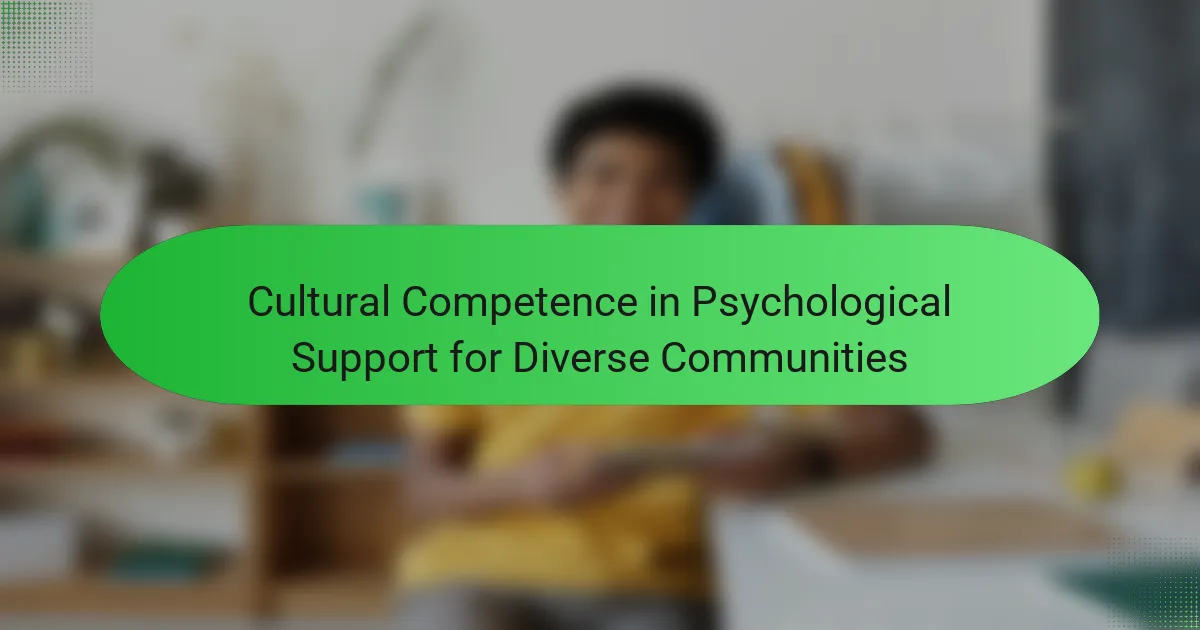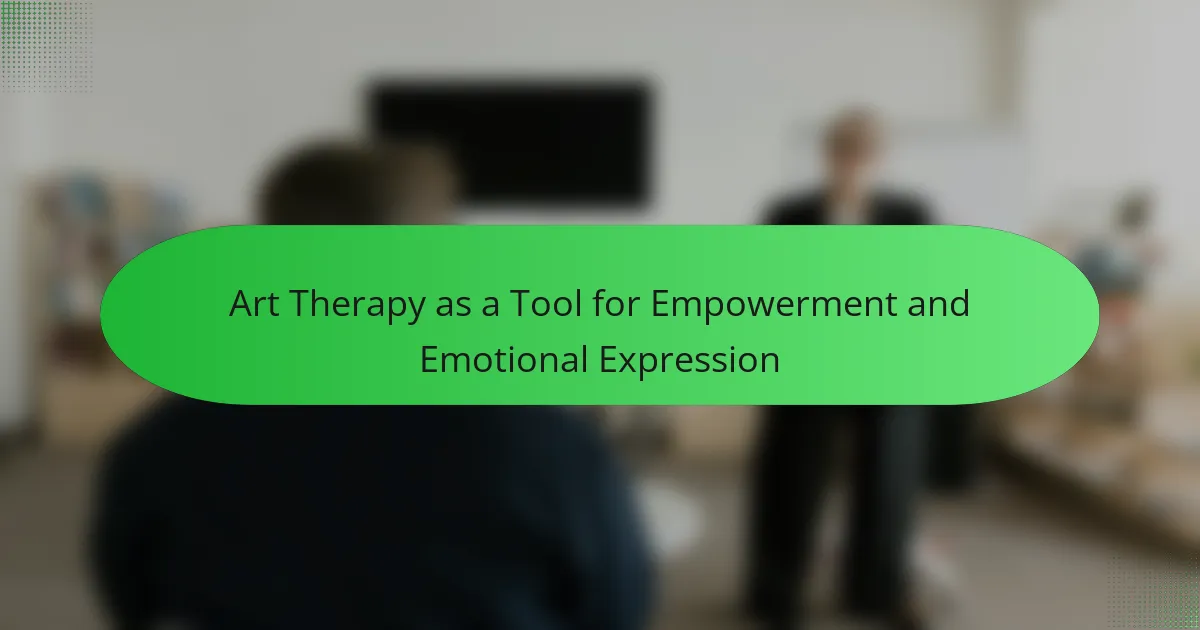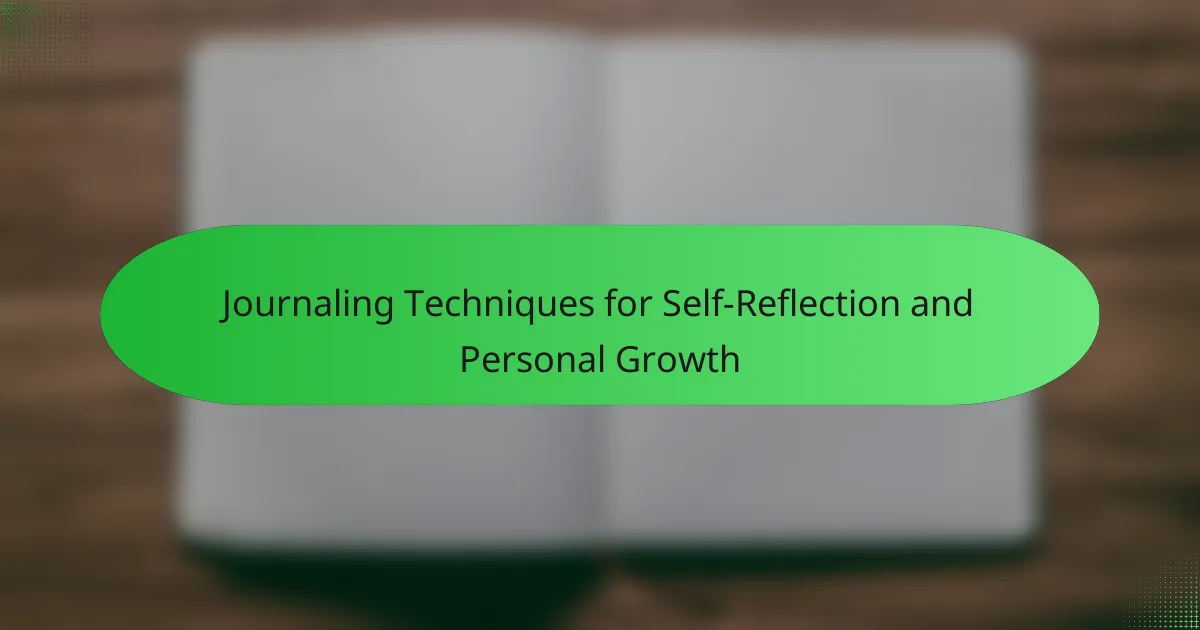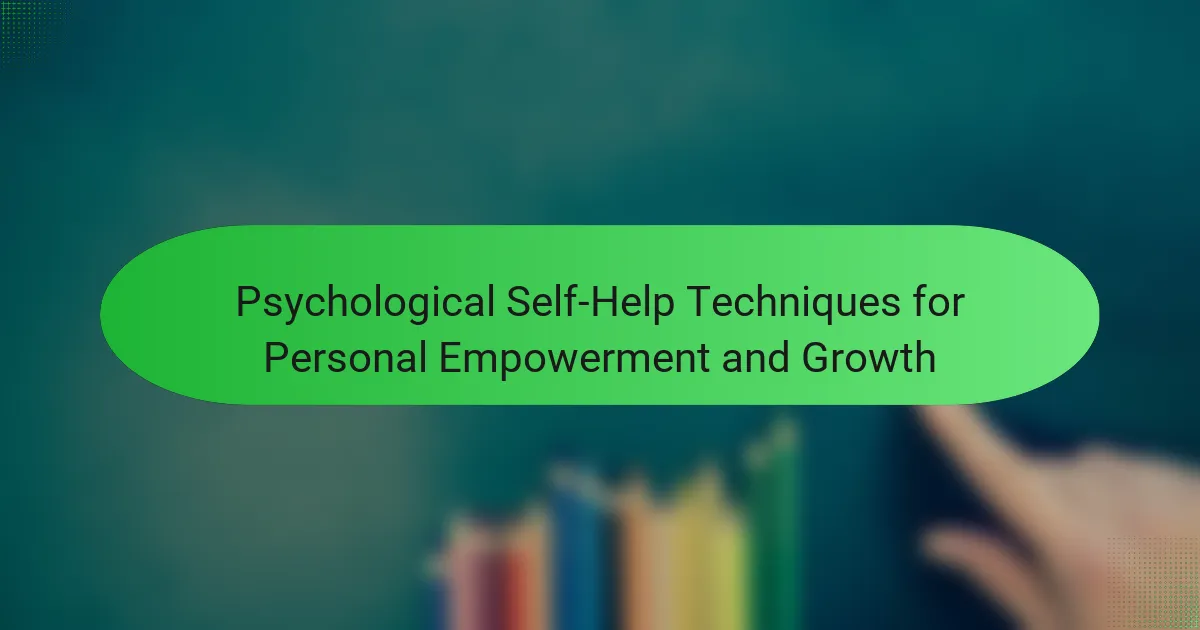Community engagement strategies enhance cultural resilience by fostering connections and shared identities. These strategies address challenges like resource limitations and varying community interests. Successful initiatives include collaborative projects and innovative tools that promote participation. Understanding cultural nuances is essential for tailoring effective engagement methods that resonate with diverse communities.
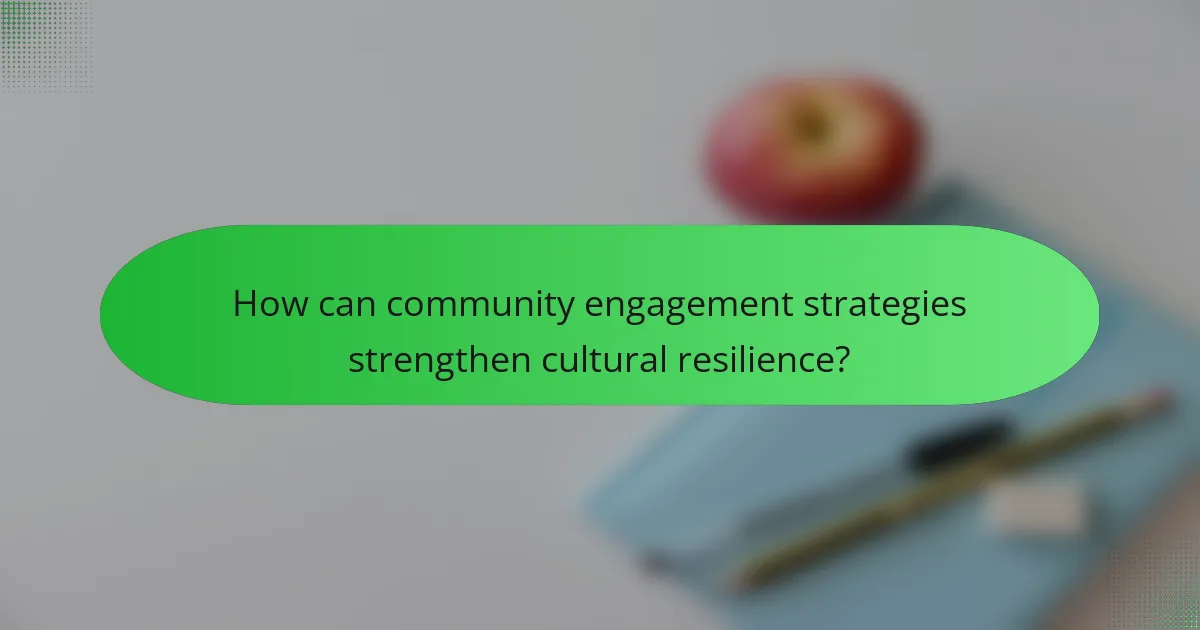
How can community engagement strategies strengthen cultural resilience?
Community engagement strategies can significantly strengthen cultural resilience by fostering connections and shared identities. These strategies encourage participation, promote cultural awareness, and enhance community cohesion. By involving diverse voices, communities can preserve traditions while adapting to change. Collaborative projects, such as cultural festivals or workshops, create platforms for dialogue, enabling the exchange of ideas and experiences. As a result, this engagement not only reinforces cultural identity but also empowers communities to respond collectively to challenges.
What role does local leadership play in fostering community engagement?
Local leadership is crucial for fostering community engagement by creating inclusive spaces and encouraging participation. Effective leaders build trust and facilitate communication among community members. They identify local needs and mobilize resources to address them, enhancing cultural resilience. Leadership also inspires collective action, promoting shared values and goals. Engaged local leaders can drive initiatives that reflect community priorities, thus strengthening social bonds and enhancing overall community well-being.
Which methods effectively promote cultural awareness and appreciation?
Community engagement strategies effectively promote cultural awareness and appreciation through interactive programs and collaborations. Initiatives like cultural festivals, workshops, and exchange programs foster understanding and respect among diverse groups.
Participatory art projects encourage community members to share their cultural narratives, enhancing empathy and connection. Educational outreach in schools can integrate cultural studies, promoting appreciation from a young age.
Utilizing social media platforms allows for broader outreach, sharing stories and traditions that highlight cultural diversity. Engaging local leaders and influencers can amplify these efforts, ensuring a wider impact on community resilience and support.
How do participatory arts initiatives enhance community ties?
Participatory arts initiatives enhance community ties by fostering collaboration and shared experiences. These initiatives encourage local participation, creating a sense of belonging and ownership among residents.
By engaging diverse groups, they promote cultural exchange and understanding. For example, community murals or theater projects can unite individuals from varied backgrounds, strengthening social networks.
Research indicates that communities with active participatory arts programs report higher levels of social cohesion and trust. As a result, these initiatives contribute to cultural resilience, allowing communities to adapt and thrive amid challenges.
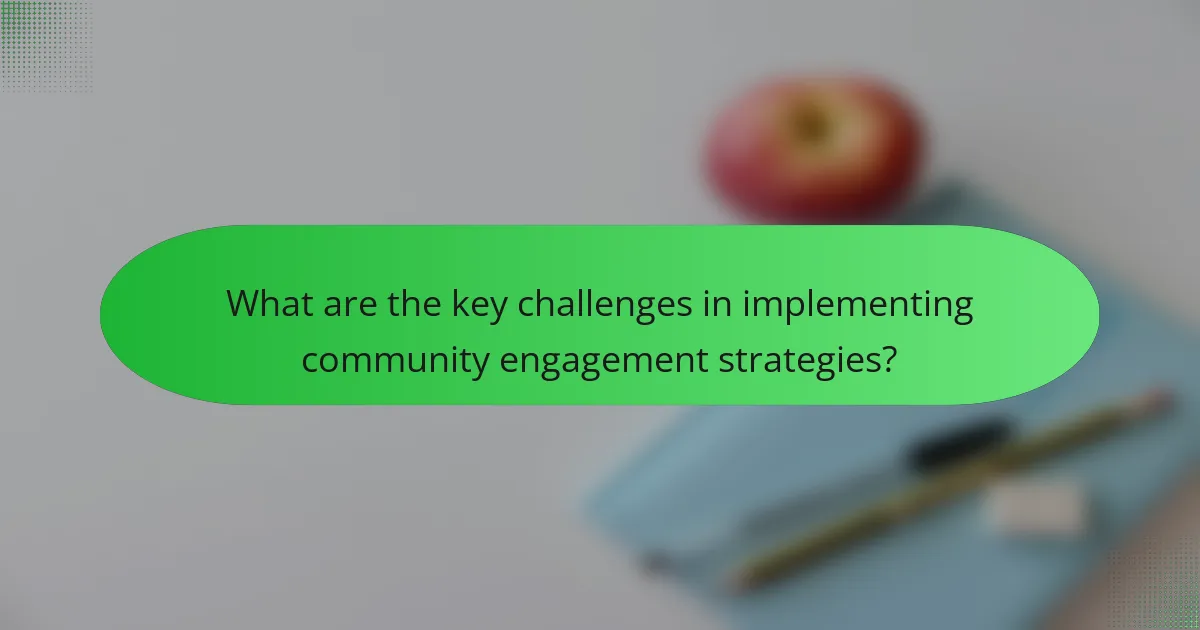
What are the key challenges in implementing community engagement strategies?
Key challenges in implementing community engagement strategies include lack of resources, insufficient stakeholder involvement, and varying community interests. These barriers hinder effective participation and can lead to disengagement. Additionally, measuring the impact of engagement efforts poses a significant challenge, as metrics may be unclear or difficult to quantify. Addressing these challenges requires tailored approaches that consider unique community dynamics and resource availability.
How do socioeconomic factors affect community participation?
Socioeconomic factors significantly influence community participation by shaping access to resources and opportunities. Communities with higher income levels often have better access to education and civic engagement platforms, leading to increased participation. Conversely, lower socioeconomic status can limit involvement due to barriers such as time constraints and lack of transportation.
For example, communities with strong economic support can organize events and initiatives that foster participation, while those facing economic challenges may struggle to mobilize residents. Additionally, social networks within socioeconomic groups can either enhance or impede participation based on shared experiences and mutual support.
As a result, addressing these socioeconomic disparities is crucial for developing effective community engagement strategies that promote cultural resilience and support. By focusing on inclusivity and resource accessibility, communities can enhance participation across diverse socioeconomic backgrounds.
What barriers exist for marginalized groups in community engagement?
Marginalized groups face several barriers in community engagement, including lack of access to resources, language barriers, and systemic discrimination. These obstacles hinder participation and limit the effectiveness of community engagement strategies.
Limited access to information and decision-making processes often excludes marginalized voices. Language barriers can prevent effective communication and understanding of community issues. Systemic discrimination may lead to mistrust in institutions, further isolating these groups.
Community engagement strategies must address these barriers by ensuring equitable access to resources, providing language support, and fostering inclusive environments. By recognizing and overcoming these challenges, communities can enhance cultural resilience and support for all members.
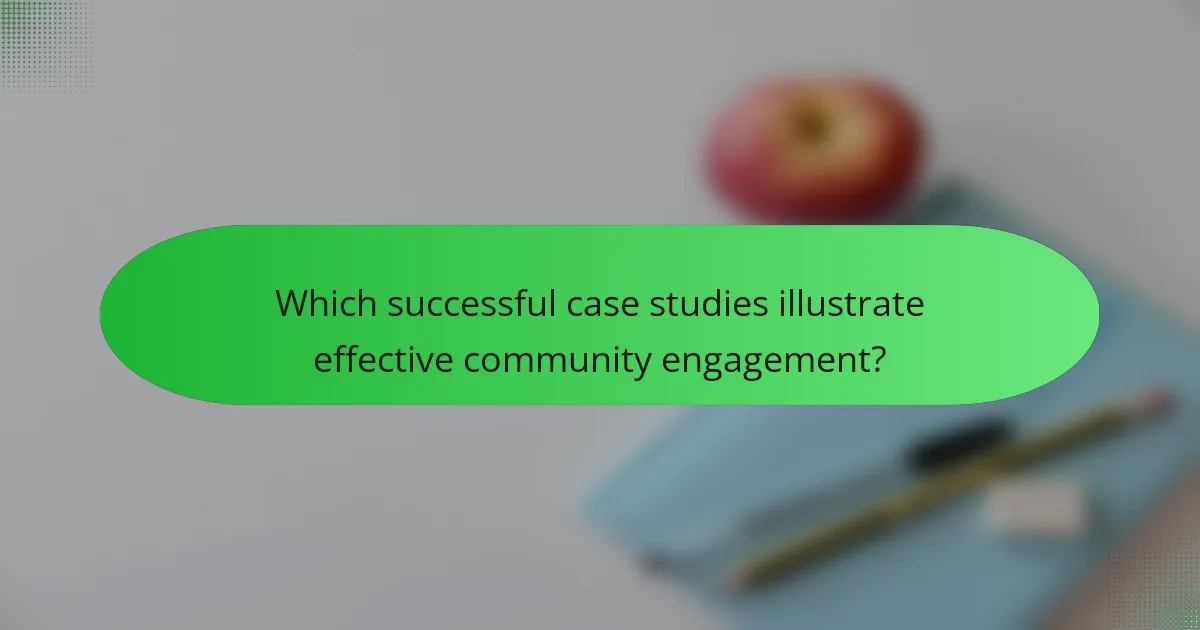
Which successful case studies illustrate effective community engagement?
Successful case studies of community engagement include initiatives that enhance cultural resilience and support. One notable example is the “Community Resilience Project” in New Zealand, which fostered collaboration among diverse cultural groups, leading to improved social cohesion and resource sharing. Another case is the “Cultural Heritage Mapping” project in Canada, where local communities engaged in documenting their cultural assets, strengthening identity and pride. These examples illustrate how effective strategies can mobilize community members, create inclusive spaces, and promote sustainable practices.
What lessons can be learned from global examples of cultural resilience?
Global examples of cultural resilience highlight the importance of community engagement strategies. These strategies foster collaboration, strengthen identity, and enhance social cohesion. For instance, indigenous communities often utilize storytelling and cultural events to preserve their heritage while adapting to modern challenges. As a result, they maintain cultural practices that empower future generations. Additionally, participatory art projects in urban areas have successfully united diverse populations, promoting inclusivity and shared cultural experiences. Such initiatives demonstrate that active community involvement is crucial for sustaining cultural resilience amid global changes.
How did community-led initiatives in urban areas foster cultural support?
Community-led initiatives in urban areas enhance cultural support by fostering local identity and collaboration. These initiatives create platforms for diverse cultural expressions, promoting inclusivity and community pride.
Engagement through events, workshops, and cultural festivals strengthens social ties and encourages participation. For example, urban art projects often involve local artists, creating unique cultural landmarks that reflect community values.
Additionally, partnerships with local organizations amplify resources, ensuring sustainability. This collaborative approach not only preserves cultural heritage but also adapts it to contemporary contexts, enhancing resilience.
As a result, these initiatives cultivate a vibrant cultural ecosystem, enabling communities to thrive amidst urban challenges.
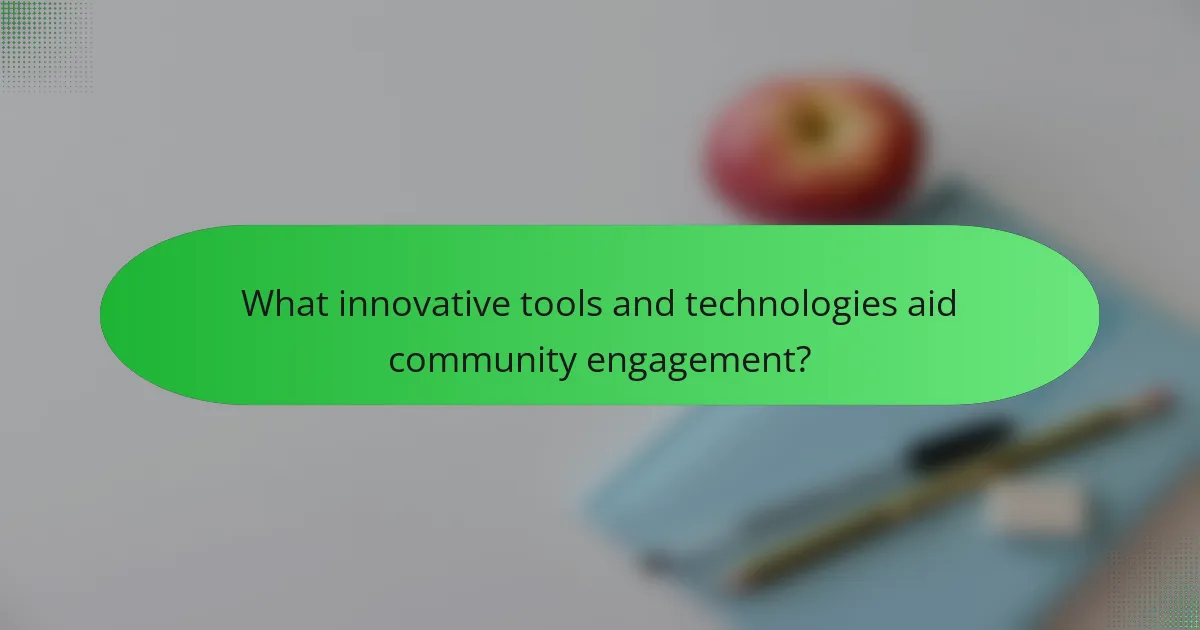
What innovative tools and technologies aid community engagement?
Innovative tools and technologies enhance community engagement by fostering collaboration and communication. Digital platforms, social media, and mobile applications facilitate real-time interaction and feedback. Geographic Information Systems (GIS) enable visualizing community needs and resources. Virtual reality (VR) and augmented reality (AR) create immersive experiences for cultural education. Data analytics tools provide insights into community demographics and preferences, guiding targeted initiatives. Finally, crowdfunding platforms empower communities to fund local projects, strengthening ties and resilience.
How can social media platforms enhance cultural dialogue?
Social media platforms enhance cultural dialogue by fostering community engagement and promoting diverse perspectives. They provide spaces for sharing stories, traditions, and challenges, encouraging users to connect across cultural boundaries. By utilizing features like live discussions, polls, and multimedia content, platforms facilitate real-time conversations that deepen understanding. Moreover, algorithms can promote content from underrepresented cultures, amplifying their voices. This active participation nurtures cultural resilience, allowing communities to share experiences and support one another effectively.
Which mobile applications are effective for community organizing?
Effective mobile applications for community organizing include platforms like Nextdoor, Meetup, and WhatsApp. These apps facilitate communication, event planning, and resource sharing among community members.
Nextdoor connects neighbors, fostering local engagement and information exchange. Meetup enables groups to organize events based on shared interests, enhancing community participation. WhatsApp allows for real-time messaging, making coordination and support more efficient.
Utilizing these applications can significantly strengthen community ties and cultural resilience. They empower individuals to collaborate, share resources, and mobilize for local causes effectively.
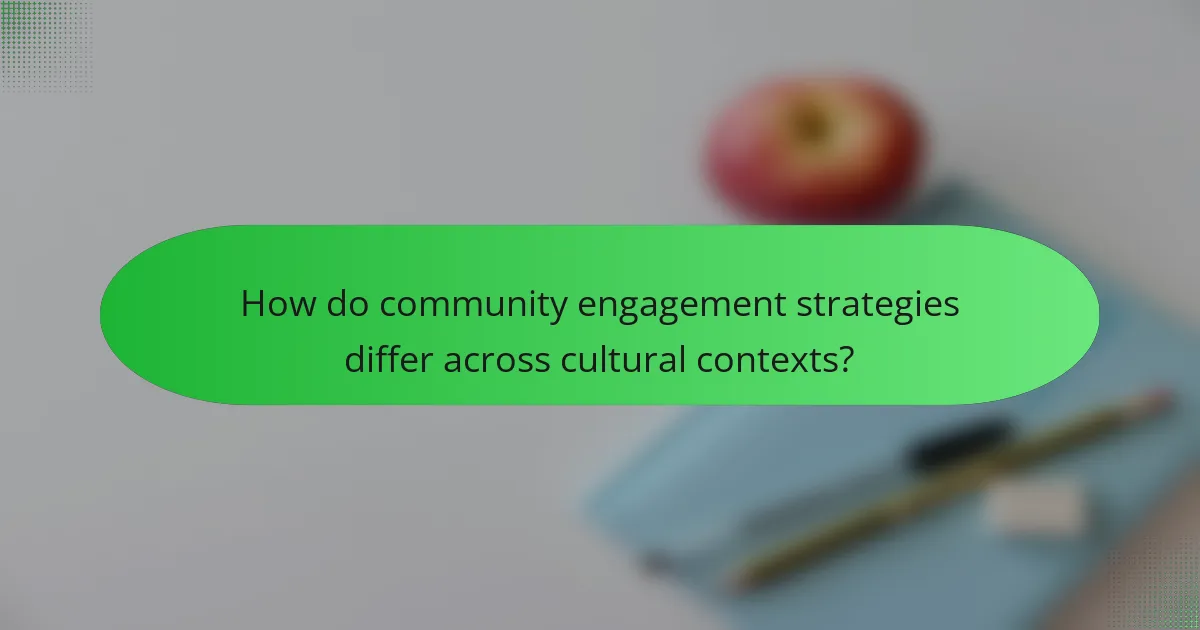
How do community engagement strategies differ across cultural contexts?
Community engagement strategies vary significantly across cultural contexts. These differences stem from unique social norms, values, and communication styles inherent to each culture. For instance, collectivist cultures often emphasize group consensus and community involvement, while individualistic cultures may focus on personal initiative and independence.
Additionally, the methods of engagement can differ. In some cultures, traditional practices and rituals play a crucial role in community gatherings, while in others, digital platforms may be preferred for outreach. Understanding these cultural nuances is essential for effective engagement and fostering resilience within communities.
Cultural context also influences the perceived benefits of engagement. In some societies, community involvement may enhance social cohesion and support systems, whereas in others, it may prioritize economic development and individual empowerment. Recognizing these diverse motivations is vital for tailoring strategies that resonate with specific communities.
Overall, successful community engagement requires sensitivity to cultural differences, ensuring that strategies are inclusive and relevant to the values and needs of the target population.
What unique approaches have been adopted in indigenous communities?
Indigenous communities have adopted unique approaches that prioritize traditional knowledge and collective decision-making. These strategies enhance cultural resilience and support community well-being. For example, many communities engage in intergenerational storytelling, which preserves language and cultural practices while fostering strong social bonds. Additionally, collaborative land management practices reflect a deep connection to the environment, integrating ecological wisdom with community needs. Such initiatives not only empower local voices but also promote sustainability and cultural continuity.
How do local customs influence engagement strategies in urban settings?
Local customs significantly shape engagement strategies in urban settings by fostering community relationships and cultural understanding. Strategies that respect and incorporate local traditions enhance participation and trust. Tailoring initiatives to reflect community values increases effectiveness and sustainability. For example, utilizing local art forms in outreach can resonate more deeply with residents. Engaging local leaders can also bridge gaps between diverse groups, ensuring inclusive participation.
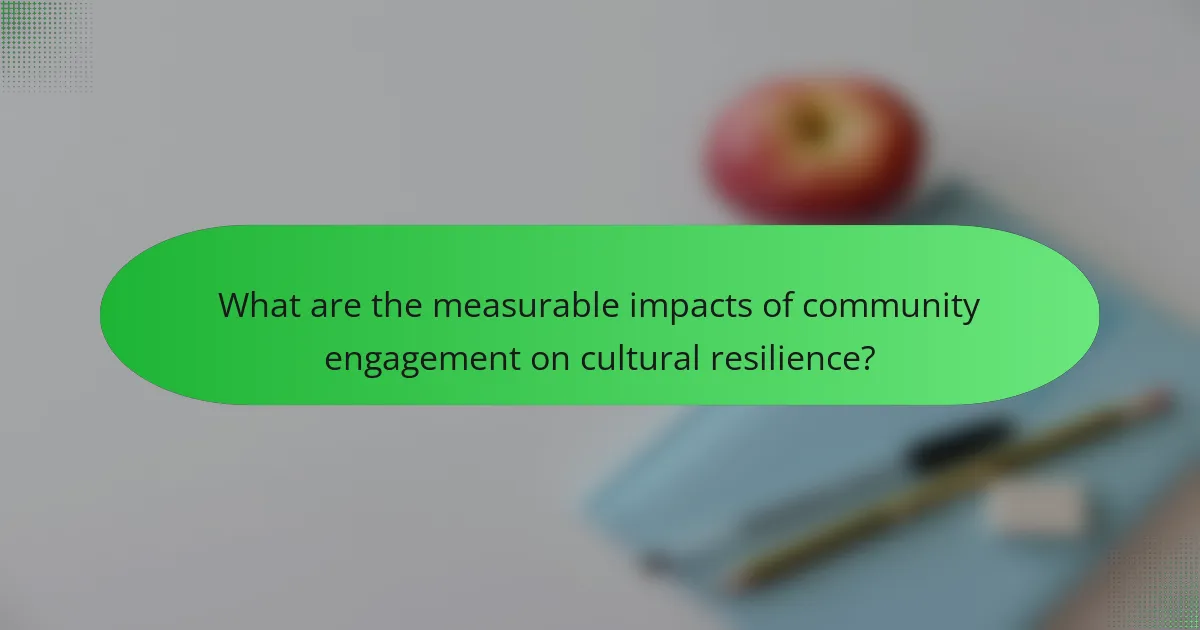
What are the measurable impacts of community engagement on cultural resilience?
Community engagement significantly enhances cultural resilience by fostering connections and shared identity. Active participation in community activities leads to increased social cohesion, which strengthens cultural practices and traditions. Engaged communities are more likely to adapt to challenges and preserve their heritage. For instance, studies show that communities involved in cultural events report a 30% increase in cultural participation and a 25% improvement in collective problem-solving abilities. Additionally, community engagement initiatives often lead to the development of local leadership, empowering individuals to advocate for cultural preservation actively. This empowerment is a unique attribute that distinguishes resilient communities, ensuring their cultural narratives continue to thrive amidst change.
Which metrics are most effective for assessing community engagement success?
To assess community engagement success effectively, focus on metrics that capture participation, feedback, and impact. Key metrics include participation rates, qualitative feedback, social media engagement, and community-driven initiatives.
| Metric | Description | Value |
|—————————|——————————————————|——————————–|
| Participation Rate | Percentage of community members involved | 75% engagement |
| Qualitative Feedback | Insights from surveys and interviews | 85% positive responses |
| Social Media Engagement | Shares, likes, and comments on community posts | 300 interactions per post |
| Community Initiatives | Number of projects initiated by community members | 15 new initiatives annually |
| Event Attendance | Turnout at community events | 200 attendees per event |
| Volunteer Hours | Total hours contributed by community volunteers | 1,500 hours annually |
How does community engagement contribute to social cohesion and cultural vitality?
Community engagement fosters social cohesion and cultural vitality by building trust and collaboration among diverse groups. It promotes shared values and collective identity, enhancing community resilience. Active participation in cultural events strengthens bonds and encourages inclusivity. Research shows that engaged communities experience lower crime rates and improved well-being, highlighting the positive impact of collaboration on societal health.
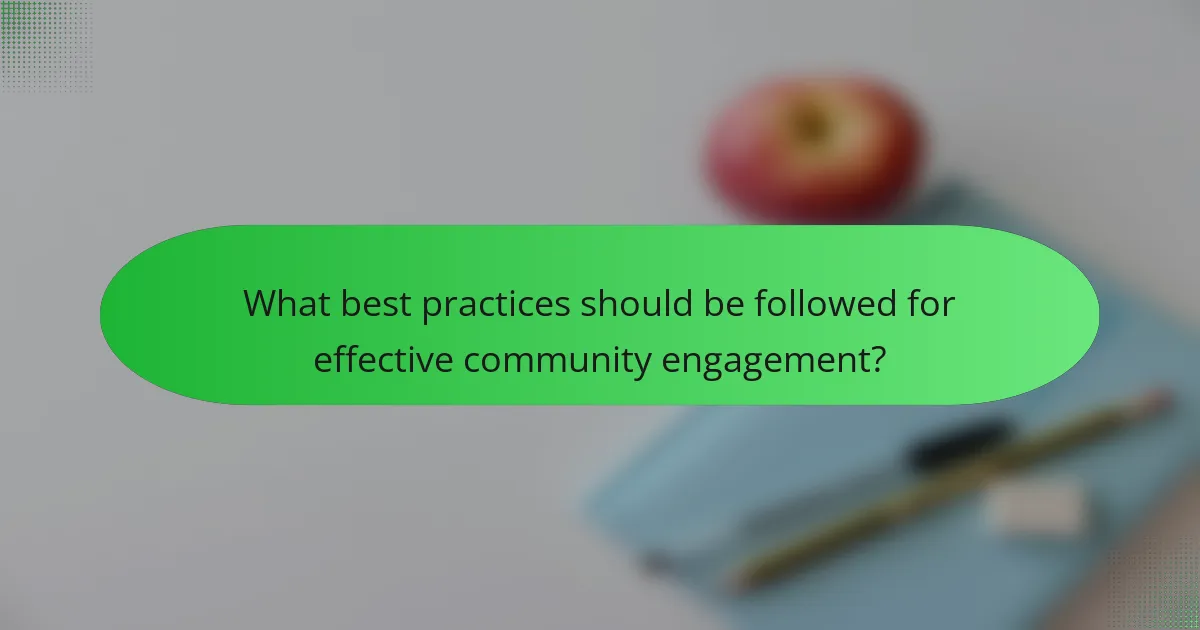
What best practices should be followed for effective community engagement?
Effective community engagement involves fostering trust, inclusivity, and active participation. Key best practices include:
1. Build relationships through regular communication and transparency.
2. Involve community members in decision-making processes.
3. Utilize diverse platforms to reach various demographics.
4. Encourage feedback and adapt strategies based on community input.
5. Celebrate cultural diversity to strengthen community identity.
6. Provide resources and support for community-led initiatives.
How can organizations build trust within communities?
Organizations can build trust within communities by fostering open communication and collaboration. Engaging with community members through regular dialogues cultivates transparency and inclusivity. Establishing partnerships with local organizations enhances credibility and demonstrates commitment to community needs.
Additionally, providing consistent support and resources strengthens relationships. For example, hosting workshops or community events can showcase dedication and create shared experiences. Recognizing and celebrating cultural diversity within the community further reinforces trust and respect.
Lastly, addressing concerns promptly and responsibly builds a reputation for reliability. This proactive approach contributes to long-term trust and resilience within the community.
What common mistakes should be avoided in community engagement efforts?
To enhance community engagement efforts, avoid common mistakes such as lack of clear goals, insufficient outreach, neglecting diverse voices, and failing to follow up. These pitfalls can hinder cultural resilience and support.
1. Lack of clear goals: Engagement efforts should have specific, measurable objectives to guide activities.
2. Insufficient outreach: Failing to reach out to all community segments limits participation and representation.
3. Neglecting diverse voices: Ignoring underrepresented groups can lead to incomplete perspectives and solutions.
4. Failing to follow up: Not providing feedback or updates can diminish trust and interest in future initiatives.
How can feedback loops improve community engagement strategies?
Feedback loops can significantly enhance community engagement strategies by fostering continuous improvement and responsiveness. These loops allow communities to gather input, assess feedback, and adapt initiatives accordingly. Engaging residents in the feedback process promotes ownership and investment in cultural resilience efforts. As a result, communities become more adaptive to changing needs and preferences, leading to stronger social ties and increased participation in cultural programs. Effective feedback mechanisms can include surveys, focus groups, and community forums, which provide valuable insights into the effectiveness of engagement strategies.
